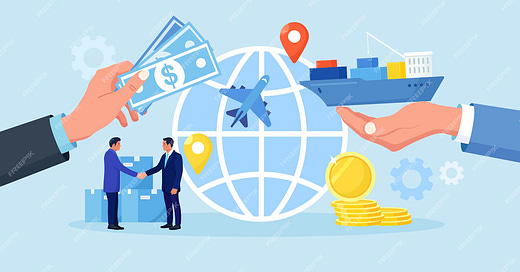Absolute Advantage, Comparative Advantage, and Gains from Trade, Part 1
This is the first in a series of lessons on International Economics, geared toward people who have a beginner's background in the subject

I received a great request from one of my readers, asking me to give some Economics lessons that will be particularly useful to people who have a beginner’s background in Economics.
I love that idea! So today, I am publishing the first in a series of articles on the theory of comparative advantage, which is where International Trade courses begin. This is an opportune time to talk about this theory given the trade war Donald Trump is waging on Canada, because it is useful for figuring out optimal retaliation strategies.
And that’s not all!
It also demonstrates why two jurisdictions will gain from trading both ways with each other, even if one side could produce everything more efficiently, and even if one side’s currency is worth more than the other side’s currency. In other words, despite how massive the U.S. economy is relative to Canada’s economy, and even when our dollar is worth more than their dollar — it happened just 10-15 years ago — they still benefit from trading both ways with us… whether a certain someone thinks so or not.
I am genuinely excited about this series!
But before I begin with this issue of my newsletter, if you enjoy what I write and find it valuable, please consider a paid subscription. It will help me to devote more resources into what I write so it will get even better!
Now onto the show.
Introduction
Following WWII, governments around the world became gradually less enchanted with protectionist trade policies, and more interested in negotiating trade liberalization agreements with one another. Such agreements have included the 1988 Canada/U.S. Free Trade Agreement (FTA), the 1994 North American Free Trade Agreement (NAFTA), and the European Union (EU). More recently, Canada has pursued trade agreements with India, China, Australia, Japan, South Korea, Panama, and the EU, as well as the multi-lateral Trans-Pacific Partnership . These pursuits are partly motivated by expected gains to Canada in terms of economic growth and employment. For example, Foreign Affairs, Trade and Development Canada (now called Global Affairs Canada) reported in 2012 that:
A Canada-India joint study concluded that a trade agreement between the two countries could boost Canada’s economy by at least . That translates to almost new jobs across the country or a boost to the average Canadian family’s annual income. A trade agreement with India would eliminate or reduce tariffs on Canadian goods, liberalize trade in services, and directly benefit Canadian workers and businesses in all regions of Canada in sectors such as primary agriculture, resource-related and chemical products, transport equipment, machinery and equipment, and services.
As for trade with China, the same government department claimed:
The Canadian and Chinese governments should continue to deepen and strengthen our bilateral trade and investment ties through appropriate bilateral instruments to ensure that Chinese and Canadian citizens can continue to build a prosperous and sustainable future.
Despite the desire of governments and economists to liberalize trade, public opinion did not seem to share this enthusiasm, both before and — perhaps especially — after the rise of Donald Trump in politics. Indeed, several anti-globalization protests occurred in cities around the world over the years, including Seattle on November 30, 1999 during a meeting of the World Trade Organization; Quebec City on April 20-22, 2001 during the Third Summit of the Americas; London on March 28 – April 1, 2009 during a G-20 summit; and Toronto on June 18-28, 2010 during another G-20 summit.
Krugman, Obstfeld and Melitz (2015, pp. 37-40) summarize the concerns of anti-globalization protesters nicely in terms of three common myths of international trade:
Productivity and Competitiveness: free trade is only beneficial if your country is strong enough to stand up to foreign competition.
Exploitation: trade exploits a country and makes it worse off if its workers receive much lower wages than in other nations.
Pauper Labour Argument: foreign competition is unfair and hurts (higher-wage) countries when it is based on low wages.1
The purpose of the following series of articles is to demonstrate that while these myths may be well-intentioned, they are ultimately misguided. It will also be argued that governments can address concerns of protesters without resorting to trade barriers. The achievement of these goals will involve an analysis of the basic Ricardian model of comparative advantage, during which time five questions will be answered:
How does international trade differ from inter-regional trade?
Why do countries trade with one another?
Why do countries export some goods and services, but import other ones?
At what prices do countries exchange exports and imports?
What specific benefits can countries achieve via international trade?



